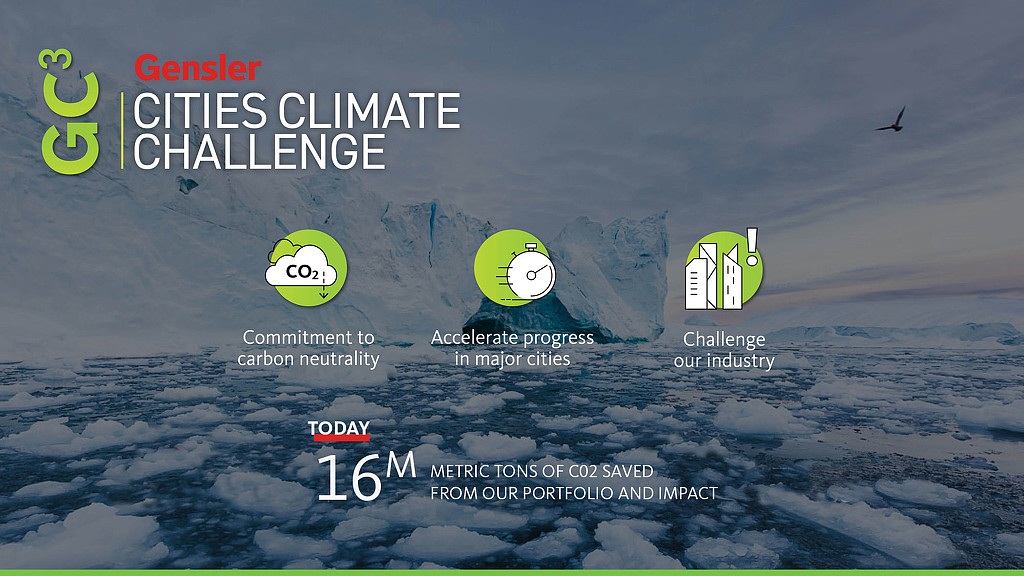Doubling Down on Our Commitment to Resilience
September 20, 2019 | By Diane Hoskins
As the world’s largest design firm, Gensler has a unique obligation and opportunity to focus on sustainability in the built environment. That’s why Gensler Co-CEO Diane Hoskins is reaffirming our commitment to the Gensler Cities Climate Challenge (GC3). Explore our Strategies for Climate Resilience in the latest Impact by Design report.
In 2015 at the COP21 conference in Paris, Gensler joined governments and private corporations in signing the Paris Pledge for Action, agreeing to significantly reduce carbon emissions in our global portfolio of work. As the world’s largest architecture and design firm — with hundreds of millions of square feet of buildings and interior design projects in the pipeline annually — we believe our impact and role in reducing energy demand is critical. We signed the Paris Pledge in solidarity with our clients, communities, and governments who are all committed to taking action.
Last year, we deepened our commitment to combat the impact on climate change in the built environment, announcing the Gensler Cities Climate Challenge (GC3). This pledge is our commitment — and our challenge to the entire design industry — to meet an ambitious goal: the elimination of all greenhouse gases associated with the built environment.
The Gensler Cities Climate Challenge (GC3)
The Intergovernmental Panel on Climate Change (IPCC) released a 2019 report emphasizing the urgent need to reduce greenhouse gas emissions for all sectors by 2020. The report states that emissions must peak by the end of this year to keep the planet from heating 3ºC by 2100. This means that we all have less than 12 months to take concrete actions to truly reduce emission levels. This analysis of only having through 2020 to make large-scale investments in order to achieve emissions goals is also shared by the Global Commission on Adaptation, a group of leaders in business, politics, and science led by the eighth Secretary General of the United Nations, Ban Ki-Moon, and co-chaired by Microsoft co-founder Bill Gates and World Bank chief executive Kristalina Georgieva. In other words, global experts with diverse backgrounds, agree that this is a problem that must be solved today.
Knowing that immediate action is required, we are fast-tracking our goals and taking immediate aggressive steps for all our work to become completely carbon neutral over the next decade. This entails our sizable annual portfolio being designed for both net-zero energy in operations and net-zero impact in construction. As the world’s largest design firm, Gensler’s impact in creating a resilient future is like no other design enterprise. We challenge all other designers, architects, developers and anyone in a position to influence the built environment to join our mission. We ask that the entire building sector join us in making sure our future is everyone’s future.
The Tangible Impact of Our Design Choices
Gensler is already leading the charge for the built environment to ensure that the global average temperature increase stays below 1.5ºC. We more than doubled our design impact between 2014 and 2016 — from a projected four million metric tons of C02 saved each year in 2014, to more than 11 million metric tons in 2017.
Increases in CO2 atmospheric levels can lead to warmer temperatures, changes in precipitation, and shifting climate patterns. Since the energy demand for buildings makes up at least 30% of all global CO2 emissions, improving our efficiency in this area is critical to the overall impact of climate change mitigation efforts. By requiring less fossil fuel and embodied energy to build, coupled with resilient building design, the building industry can be a major player in a pathway to keep average temperature increases under critical levels.
According to the latest Gensler Impact by Design report, our work is already performing 42% better than baseline performance. Our 2019 portfolio, which included over 7,000 projects representing over 1.5 billion square feet of design work, is estimated to have saved approximately 16 million metric tons of CO2 from being emitted into the atmosphere compared to average building energy usage. To put this into perspective, our current actions are tantamount to powering 1.9 million homes for an entire year — or the equivalent of taking 4.2 coal-fired power plants offline for an entire year.
That represents a significant impact, but it’s not enough. We continue to lead by example and push other architecture and design firms to play a more significant role in battling climate change. Moreover, given the critical situation laid out in the IPCC report, our goal is to get every project we design to net-zero for energy and water consumption as quickly as possible.
Challenging Our Partners and Industry to Make an Impact
There is also mounting pressure for the land use and real estate industry to take action. In addition to heat waves slowing construction, one report concluded that real estate investors have not prepared their properties for catastrophic weather events and could be vulnerable to steep costs. Additionally, extreme weather events are damaging residential developments, exacerbating the affordable housing shortage.
This message of taking immediate action was echoed by the real estate industry at the Urban Land Institute (ULI) 2019 Fall Meeting in DC, where increasing climate destabilization is now forcing real estate development professionals to address scenarios that they have never encountered in the past. During the ULI conference, Harvard-trained economist and fellow at the Woods Hole Research Center, Spencer Glendon, stated that the climate change will have drastic effects on commercial real estate in near future, both jeopardizing the viability of development projects and altering our long-held notions of how financers value buildings and land. Additionally, he makes the case that the financial sector will soon be reluctant to offer long-term loans for some developments and, “we will see a loss of commercial insurance in many places.”
In 2019, the Business Roundtable of top CEOs in the country, issued a signed statement in agreement that companies should focus on all stakeholders, including a corporation’s duties to customers, their communities, their suppliers, and their employees. A total of 200 top CEOs signed the statement, agreeing that maximizing profits in all situations can no longer be the singular goal of corporations.
As part of our commitment, Gensler participated in a special climate summit held in the fall of 2019 in New York, organized UN Secretary-General Antonio Guterres, who called on all leaders to present “concrete, realistic plans to enhance their nationally determined contributions...in line with reducing greenhouse gas emissions by 45 percent over the next decade.” There, as participants in these talks, Gensler publicly introduced the new GC3 challenge for the design industry.
Today, we are reaffirming our commitment to focus on making an impact on climate change by working to achieve our goal to eliminate all greenhouse gases associated with the built environment, while challenging our industry and partners to join us in this mission to promote the well-being of our planet.

